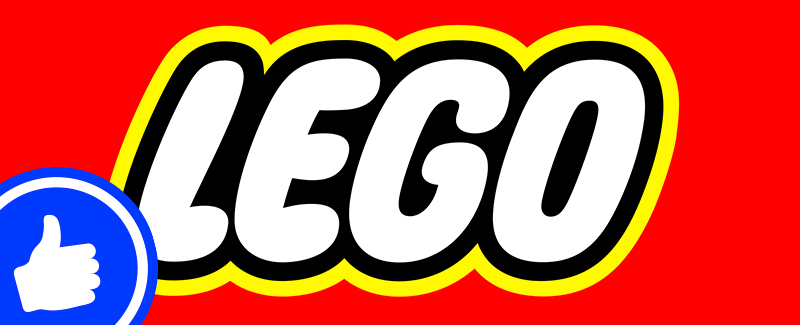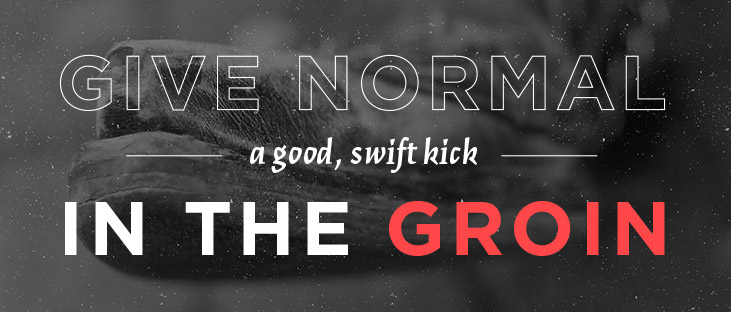 Branding
Branding
Brands We Like: LEGO
Like most kids growing up a few years decades ago, I spent my free time (gasp!) without any mobile electronic devices, video game consoles or endless internet distractions. Instead, I split my time up into outdoor sports and playing with my favorite toys. Sports were awesome but, man, I loved my toys. I can remember spending countless amounts of hours with my Evil Knievel wind-up motorcycle, my GI Joe and Star Wars figures and, my favorite of them all, my LEGO collection. That’s why we are featuring Lego in this month’s ‘Brands We Like’ post.
I can remember it now, sifting through that big green bucket of pieces, wondering what it was I was going to build. A ship? A skyscraper? Some sort of awkwardly designed, non-aerodynamic spacecraft? Regardless of the decision, the best thing about LEGO for me was that I could stop on a dime and shift gears. If that ship turned out to look more like a dog, so be it. I could just change my plan and swap a few pieces out to add a tail and four legs. Or, if halfway through the build, my soon to be Death Star looked more like Oscar’s garbage can, it was all good. I’d just shuffle out some colors and craft a lid to add. Presto! A prop worthy of my Sesame Street.
If you think about it, this ability to pivot and change while building LEGOs is similar to one of the many brand strengths that has kept LEGO as relevant today as it was when I was a kid. One could actually argue that it is more relevant now than ever before. Why? Because just as I did as a youngster, the folks behind the LEGO brand have been able to change and adapt to the times easily. Each change carefully thought out to gain exposure and make connections with new generations of LEGO builders, block by block. The LEGO brand has many moving pieces, but two of the major marketing plans that the company has adopted have, in my opinion, put them where they are today.
Wait! I Can Build That?
Take a look through the suggestions for family movies on Netflix or at your Redbox and you’ll see flicks like Harry Potter, Star Wars, Batman, Lord of the Rings, SpongeBob and Pirates of The Caribbean. Then, take a stroll through your local toy store or browse Amazon and you’ll see those titles, too. But, there you’ll see them on stacks of brightly colored boxes, right next to that LEGO logo that we have grown accustomed to. Often times, those shelves are nearly empty, as kids and parents alike flock to the stores for their latest releases.
LEGO began to license products in 1999 when they issued Star Wars and Winnie The Pooh playsets. It was the first in a series of expensive moves to begin righting a brand that was quickly beginning to lose money. Children weren’t playing with toys as much as they used to, and executives saw being married to these movies and their popular characters as a way to be more visible. Followed by a new CEO and the sale of their profitless Legoland amusement parks, these licensing deals were one of the main reasons that LEGO catapulted back into the spotlight.
Take a look at this infographic from Wired.com.
The cost of licensing in comparison to money returned? Now, those are profits to build on.
Everything is Awesome
Not only did LEGO associate themselves with popular tv shows and movies with licensing deals, but they also used the two mediums in completely different ways to stay relevant. As mentioned before, kids were spending less time playing with toys, and we all know why. Their electronics, particularly their video game consoles and mobile devices had their attention, and they gave them the ability to watch or play them wherever they were. What would LEGO do? How could they compete with that? After a little debate, the answer was pretty clear. LEGO would put themselves right where the kids were.
In 1999, when the LEGO minds cooked up their licensing deals, they had the foresight to not only include agreements for their toy sets but for LEGO video games and movies, as well. So, after the release of some brand video games that didn’t fare so well in the profit margin, LEGO released some new titles in the electronics and gaming aisles. Utilizing those licensing deals, the titles would include names like “LEGO: Batman”, “LEGO: Indiana Jones” and “LEGO: Star Wars”. These games would sell well, some of the times topping handheld game charts. They sold so many units, in fact, that a new generation of ‘builders’ couldn’t escape the LEGO name.
When you add several LEGO lines into the marketing mix that would eventually become TV shows and movies in their own right, the brand became more visible and stronger than ever before. In the early 2000s, titles like Bionicle and Legends of Chima were on the air on the tv screen, and a LEGO movie was about to be produced for the big screen. It would turn out to be a big hit with kids everywhere singing the movie’s theme song. It was official; LEGO was NOT going anywhere. (That song kinda got stuck in my head, too. So, here. Watch.)
These additions to LEGOs’ marketing plan were just a few of the main reasons why the LEGO brand still resonates today. The licensing deals, video games, shows and movies wouldn’t mean a thing, though, if the product didn’t keep its quality or entertainment factor. Their ‘it’ (why they do what they do) has never changed and, while their strategy on how to get to their ‘one’ (their ideal customer) may have had to switch up once in a while, their target has always remained the same.
I have to admit. They’ve got me. In my house, you’ll see the LEGO brand displayed on my 14-year-old daughter’s shelves. (She has every Harry Potter set but two.) You’ll see it on the hand-held’s game screen at the same time as a LEGO show appears on my TV. (My son has a problem.) And, you’ll also see it on occasional weekends, as an older bald man crawls around on his hands and knees trying to build that spaceship that never resembles my original plan. You might also see my wife helping, too. But, I’m pretty sure that’s so I don’t leave any pieces on the floor for her to step on.



